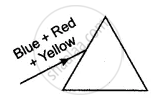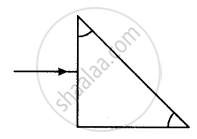Advertisements
Advertisements
Question
The process of separation of light into its component colours while passing through a medium is called _______.
Options
reflection of light
refraction of light
dispersion of light
absorption of light
Solution
The process of separation of light into its component colours while passing through a medium is called dispersion of light.
APPEARS IN
RELATED QUESTIONS
Describe an activity to show that colours of white light splitted by a glass prism can be recombined to get white light by another identical glass prism. Also draw ray diagram to show the recombination of the spectrum of white light.
Why do the component colours of incident white light split into a spectrum while passing through a glass prism, explain
(i) A ray of white light breaks up into its components while passing through a glass prism. Draw a ray diagram to show the path of rays.
(ii) Mark the least deviated colour in your diagram

(iii) Why do different coloured rays deviate differently in a prism?
Name the process which is involved in the formation of a rainbow.
The splitting up of white light into seven colours on passing through a glass prism is called:
(a) refraction
(b) deflection
(c) dispersion
(d) scattering
Why do you not see a spectrum of colours when light passes through a flat pane of glass?
You are given a disc divided into seven sectors with colours violet, indigo, blue, green, yellow, orange and red in them. What would be its colour when it is rotated rapidly?
Define the term dispersion of light.
Explain the cause of dispersion of white light through a prism.
- A beam of monochromatic light undergoes minimum deviation through an equiangular prism, how does the beam pass through the prism, with respect to its base?
- If white light is used in the same way as in part (a) above, what change do you expect in the emergent beam?
- What conclusion do you draw about the nature of white light in part (b)?
Complete the ray diagram given below to show the nature of light produced on the screen.

In an experiment to trace the path of a ray of light through a glass prism for different values of angle of incidence a student would find that the emergent ray:
(A) is parallel to the incident ray
(B) perpendicular to the incident ray
(C) is parallel to the refracted ray
(D) bends at an angle to the direction of incident ray
Draw a labeled ray diagram to illustrate the dispersion of a narrow beam of white light when it passes through a glass prism.
Make the correct choice for each of the following:
Which one of the following Fig correctly shows the path of the ray through the glass block?
Write three conditions necessary to obtain a pure spectrum on a screen. Name the instrument in which the conditions stated by you are fulfilled.
In the figure, a beam of light consisting of three colours blue, red, and yellow is incident on a prism and on a rectangular glass block respectively. Complete the diagram by drawings of the refracted and emergent rays.

In the diagram, a narrow beam of white light is incident on a right-angled isosceles prism. The critical angle of the material of prism for the yellow colour of white light is 45°. Complete the diagram to show the path of blue, yellow, and red colours of white light till they emerge out of the prism.

The sunlight can be split into its constituent colors using ______.
Say TRUE or FALSE
After passing through a prism, white light splits into a band of seven colours
State the colour which bends:
- The most.
- The least while passing through a glass prism.
